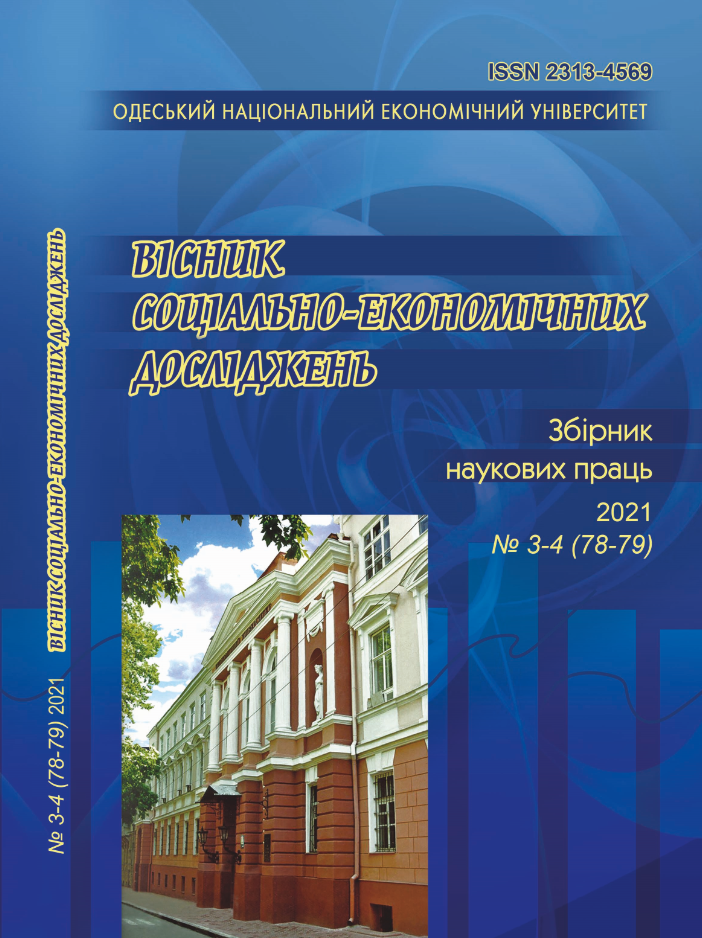ПОБУДОВА МАТЕМАТИЧНОЇ МОДЕЛІ ПРОЦЕСІВ РОБОТИ ТРАНСПОРТНИХ СИСТЕМ З ВИКОРИСТАННЯМ МЕТОДІВ НЕЧІТКОЇ ЛОГІКИ
DOI:
https://doi.org/10.33987/vsed.3-4(78-79).2021.98-106Ключові слова:
математичне моделювання, алгоритмізація, методи оптимізації, транспортні системи, пасажирські перевезенняАнотація
У статті наголошено на тому, що удосконалення управління, перебування та використання нових методів оптимізації роботи на маршрутах міського пасажирського транспорту є основними завданнями організації маршрутних перевезень у розглянутих транспортних системах. Пошук цих методів спрямований на раціональне використання ресурсів, транспортних засобів, на задоволення потреб населення у пересуванні та удосконалення якості обслуговування при здійсненні пасажирських перевезень. Для здійснення оптимального управління роботою на маршруті міського пасажирського транспорту візьмемо в якості мети побудову розкладу руху транспортних засобів на маршруті, а саме створення графіків випуску транспорту та раціональної організації роботи. При створенні цих розкладів враховується ефективне використання автомобільного парку підприємств, забезпечення безпеки перевезень пасажирів, зниження вартості послуг для населення. У цій статті вивчення пасажиропотоків на певній ділянці транспортної мережі та робота маршруту на ній розглядаються за допомогою нечітких логічних методів, що дає в результаті розгляду мінімізацію часу обслуговування та максимальний рівень задоволеності пасажирів використанням транспорту. При цьому реалізується механізм роботи з неточними поняттями в процесі пошуку рішення, вхідні дані ми можемо уявити як нечіткі безлічі, над якими здійснюються логічні дії. У даному дослідженні для чисельного вираження ступеня задоволення потреб пасажирів обирається функція приналежності до декількох тимчасових інтервалів, яка вибирається цільовою функцією пошуку оптимального розкладу руху в дані тимчасові інтервали. При пошуку рішення враховується система обмежень, що застосовуються до тимчасових інтервалів використання транспортних засобів. При цьому критерій оптимальності відображає вартість роботи графіка, що включає вартість часу експлуатації транспортних засобів і вартості часу очікування пасажирів при пересуванні за маршрутом.
Посилання
Levkovets, P. R., Moroz, M. M., Kobyletskiy, R. V. (2007). Improving the logistics management of passenger transportation [Udoskonalennia lohistychnoho upravlinnia perevezen pasazhyriv], Visnyk KDPU imeni Mykhaila Ostrohradskoho, Vyp. 6 (47), s. 113–115 [in Ukrainian]
Ceder, A. (2006). Planning and Evaluation of Passenger Ferry Service in Hong Kong. Transportation, Vol. 33, pp. 133–152.
Ceder, A., Voß, S., Daduna, J. (2001). Efficient Timetabling and Vehicle Scheduling for Public Transport. Computer-Aided Scheduling of Public Transport. Lecture Notes in Economics and Mathematical Systems, Vol. 505, pp. 37–52.
Gorbachov, P. F., Lyubiy, Ye. V. (2014). Modeling of demand for transportation of the population of small towns population by route passenger transport: monograph [Modeliuvannia popytu na perevezennia naselennia malykh mist marshrutnym pasazhirskym transportom: monohrafiia], KhNADU, Kharkiv, 257 p. [in Ukrainian]
Alvarez, A., Casado, S., Gonzalez Velarde, J., Pacheco, J. (2010). A computational tool for optimizing the urban public transport. Journal of Computer System Sciences International, Vol. 49 (2), pp. 244–252.
Leurent, F. (2011). Transport capacity constraints on the mass transit system: systemic analysis. European Transport Research Review, Vol. 3, pp. 11–21.
Marieke, S. van der Tuin, Pel, A. J. (2020). The disruption transport model: computing user delays resulting from infrastructure failures for multi-modal passenger & freight traffic. European Transport Research Review, Vol. 12, pp. 1–10. DOI https://doi.org/10.1186/s12544-020-0398-9
Zadeh, L. A. (1965). Fuzzy sets. Information and Control, Vol. 8 (3), pp. 338–353.
Bellman, R. E., Zadeh, L. A. (1970). Decision-Making in a Fuzzy Environment. Management Science, Vol. 17, pp. 141–164.
##submission.downloads##
Опубліковано
Номер
Розділ
Ліцензія
Авторське право (c) 2021 Вісник соціально-економічних досліджень

Ця робота ліцензується відповідно до Creative Commons Attribution 4.0 International License.






